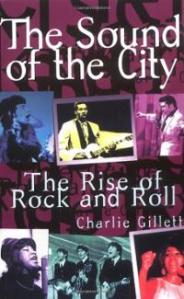 I mentioned on Facebook recently that I had started reading “The Sound of the City“, a book about popular music in the last half of the 20th century written by Charlie Gillett, the UK musicologist/writer/broadcaster.
I mentioned on Facebook recently that I had started reading “The Sound of the City“, a book about popular music in the last half of the 20th century written by Charlie Gillett, the UK musicologist/writer/broadcaster.It really was a pioneering work, at least in its first edition, published in 1970. In it, Gillett maintined that “real” rock’n’roll, ie the American kind that grew out of R’n”B, had expired sometime around 1960. He conveniently manages to ignore such minor details as Sha Na Na’s appearance at Woodstock, an occurence that would seem to suggest that the music wasn’t quite as dead as his neat categorizations would suggest.
However, now reading the 3rd edition (1995, I believe), Mr. Gillett’s work has some shortcomings that cannot be ignored. First, his undeniable need to lecture. Comtemporary accounts of the period about which he is writing are haphazard at best. There is darn near a disputable “fact” on every page, but Gillett would have you believe that his work is somehow Divine gospel. For an example off the page I just happen to be currently reading, he misses the now commonly-accepted fact that Ike Turner wrote “Rocket 88”.
Second the style is dry as stale toast. There is little anecdotal account, almost no quotation, just Mr. Gillett droning on and on. In this respect, I would contrast it with Michael Lewis‘ “Moneyball“, where Mr. Lewis makes a book about the importance of baseball statistics (!) read like a thriller.
